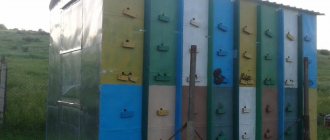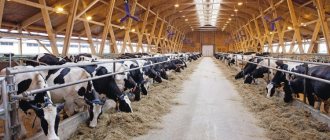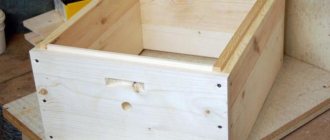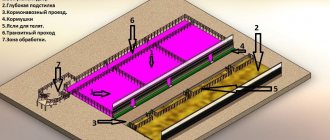In modern beekeeping, various designs are used for comfortable keeping of bees, helping to improve the quality of honey products, increase their quantity and simplify the work of the beekeeper. One of these structures is the Berendey cassette pavilion, designed for convenient spring and summer roaming. It gained popularity due to its compactness, mobility, lightness, and reliable protection of bee colonies from getting wet and freezing. A beekeeper can make a Berendey cassette pavilion with his own hands, having prepared all the necessary materials and drawings.
The history of the bee pavilion
The “domestication” of bees for the purpose of using the honey they produce goes back to ancient times. In particular, it is known for certain that such a craft was developed in Ancient Egypt, as well as in the Kingdom of Israel mentioned in the Bible, that is, it existed at least a thousand years before the birth of Christ. Initially, people used simple devices as houses for bees.
Did you know? The patent for the invention of the frame hive belongs to the American Lorenzo Loren Langstroth, who invented its vertical model 37 years later than the Ukrainian beekeeper, but, unlike the latter, took care to protect his copyright. Two more beekeepers who independently created similar structures in 1838 and 1852 were the Pole Jan Dzierzhon and the German August von Berlepsch.
So, in Asia and Africa, clay nests were made for this purpose, and in Rus', rich in forests, bees were even housed in homemade hollows, which were specially hollowed out in trees, and then, together with the swarm that settled in them, they were cut out and moved closer to the places where the rich grew. plant pollen. Only at the beginning of the 19th century, beekeeper from the Chernigov province Pyotr Prokopovich came up with a special hive design that involved the use of mobile frames.
Over the next century and a half, frame hives gained enormous popularity and began to be used all over the world in a variety of modifications, constantly supplemented and improved. However, with the development of technology and the need to create larger and more mobile apiaries, beekeepers gradually began to come to the conclusion that such structures have a number of significant drawbacks, ultimately leading to mass diseases and deaths of bees.
In particular, conventional frame hives:
- suggest a fairly high overcrowding of inhabitants, which is perhaps the main reason for the decline in honey productivity;
- very poorly ventilated inside;
- accumulate a large amount of moisture, which in winter leads to freezing of the structure through;
- inconvenient for garbage collection and disinfection, as a result they quickly become a place for the accumulation of viruses, bacteria and fungi dangerous to bees;
- are often attacked by rodents, especially in winter (uninvited guests, in turn, are carriers of many dangerous diseases and, in addition, making their way to warmth and food, destroy the integrity of the hive);
- very bulky and poorly suited for transportation.
Important! Any bee pavilion allows you to increase the production of honey from one family by one and a half to two times, even without the use of migration, that is, transporting bees to places where honey plants bloom (in the latter case, honey yield sometimes increases ten times or even more).
Thus, around the middle of the twentieth century, the first cassette hives and entire pavilions began to appear, which were multi-tiered thin-walled structures made of wax-impregnated wood and intended for year-round residence of an almost unlimited number of bee families.
The main advantages of cassette bee pavilions are, therefore, compactness, lightness, mobility, protection from getting wet and freezing, excellent ventilation inside, the ability to separate groups of insects from each other, which prevents the development of infections, as well as easy access to the contents of the hive (important for removing framework, and to inspect the condition of the bee colony).
The Berendey bee pavilion is a type of cassette pavilion, developed in 1994 by a family of Russian beekeepers from Tver named the Grachevs. As is usually the case, the idea of the original design was dictated by the need to solve a very specific problem: to minimize the time required to care for the apiary. The fact is that, having moved to Moscow for permanent residence, the Grachevs tried to breed bees on their plot of land, where they could only go once a week.
Having heard about modern bee pavilions replacing frame hives, the head of the family approached the issue with all responsibility: he read specialized literature, talked with experts, studied all the weaknesses of existing structures and tried to draw up drawings in such a way as to reduce all these shortcomings to a minimum. This is how the design appeared, which later received the beautiful name “Berendey”.
Did you know? The word “Berendey” is usually associated with the name of the wise king from the famous play “The Snow Maiden” by A. N. Ostrovsky, but in reality, the Berendeys are a very real nomadic people who inhabited the steppe zone of the Russian principalities in the 11th–13th centuries and were mentioned in many chronicles. According to one version, it was the Berendeys who became the ancestors of the Ukrainian Cossacks.
Mobile
This type of pavilion resembles a trailer. There is a beekeeper's pantry and beehives on it. It is recommended to arrange the beekeeper’s room in such a way that it has a passageway - this way the beekeeper will have easy access to the houses.
The main structure of a mobile pavilion is no different from a stationary bee house. The same wooden building with a flat or gable roof. The main difference is the lower part. If a foundation is poured for a stationary house, then the mobile structure is placed on a chassis.
Usually the chassis is a trailer of a truck or agricultural equipment. During construction, it is jacked up and placed horizontally on supports. The sides of the trailer are removed, leaving only the frame. It will serve as a foundation. The metal frame of the future house is welded to the size of the frame. Sheathing is done with chipboard, boards or other material.
For stationary use, the building can stand on supports. At the beginning of the season, the structure is raised with jacks. The supports are removed from under the trailer. The pavilion with the bees is hooked to the car and taken out to the field closer to the honey plants.
The cassette mobile design has many advantages:
- Increasing the harvest due to the access of the apiary directly to the seasonal flowering honey plants. Honey yield doubles. Overcoming a shorter distance, the bees bring 100% of the collected product to the honeycombs.
- The beekeeper is given the opportunity to obtain pure honey from one variety of honey plant. Bees will only carry the product from flowers growing nearby. During the season, with frequent moves, you can get several varieties of pure honey, for example: acacia, sunflower, buckwheat.
- The ease of maintenance of a mobile pavilion is the same as that of a stationary structure. The bees remain in their houses for the winter.
The only disadvantage of the mobile pavilion can be considered the impossibility of supplying communications. However, plumbing and sewerage are not so important for bees. Elements of comfort are in demand by beekeepers. As for lighting and heating, wiring is needed. During the winter, the house stands in the yard. The cable is connected to the home electrical network. Light appears inside the pavilion. Heating for bees is provided by electric heaters.
Advantages and disadvantages
So, “Berendey” has all the advantages that distinguish a bee pavilion from a frame hive, as well as some additional advantages.
- So, the advantages of Grachev’s design include:
- ease of manufacture;
- availability of accurate drawings and the ability to choose the appropriate model for specific requests;
- sustainability;
- maximum ease of maintenance, including cleaning, disinfection, feeding bees, etc.;
- mobility and lack of difficulties with transportation (suitable for nomadic beekeeping);
- creating an optimal temperature regime without additional heating in winter (the pavilion operates on the principle of a thermos, and therefore does not overheat in summer and does not overcool in winter);
- accessibility and ease of use regardless of weather conditions;
- universal purpose (can be used both as a stationary and as a mobile device, used for breeding and selection work, as a pollinating honey apiary, or specialized in the production of honey, wax, royal jelly, etc.);
- ensuring higher rates of honey productivity, including through a rapid increase in the number of working individuals, as well as increasing their strength (pavilion housing of bees is characterized by the absence of defective and weak colonies);
- great space savings (to place an apiary it is enough to occupy a very small area).
- Among the shortcomings that remain unresolved, we can only note:
- fire hazard (unfortunately, inevitable when using natural raw materials - wood is a material that is easily flammable);
- lack of sufficient space during work as an inevitable price for increased compactness and mobility;
- lack of lighting;
- the risk of a certain confusion due to the large number of cassettes located close to each other (to prevent the so-called wandering of bees, the risers are always painted in different contrasting colors).
Content specifics
When caring for pavilions, standard rules are followed: in the spring, bee colonies are carefully inspected, structures for disinfection are treated with special solutions; The cassettes are replaced in a timely manner, honey is regularly pumped out, the inside of the structure is kept clean, and in the winter the buildings are insulated with special shields.
The caveat of using the pavilions is the limited internal space, so you need to move inside carefully. During work, it is important not to make noise and carefully look after insects. The fire hazard of structures must also be taken into account. Because the materials from which the cassettes are assembled are highly flammable.
Berendey pavilions are considered a progressive method of breeding and keeping bees. The simple design greatly simplifies the procedure for caring for insects and transporting them. You can purchase ready-made structures or assemble pavilions with the required parameters yourself.
Making the Berendey pavilion with your own hands
“Berendey” in the author’s version has clearly defined dimensions and technological features, so that to manufacture it you just need to follow the drawing.
It looks like this:
Depending on the volume of production, the structure can be created for 46, 32 or 16 bee colonies (to accommodate the latter, it is enough to have at your disposal a regular trailer for a passenger car, designed for 700 kg of weight; for the first two, you will need a light-duty cargo transport).
Important! Ready-made bee pavilions “Berendey” can be easily found on sale, but making a generally simple structure with your own hands will save at least 40% of money, and if you skillfully use the existing remnants of various building materials, the costs will be even lower.
Typically, the structure is installed on four posts and can be moved vertically from a minimum height of 40 cm to a maximum height of 180 cm above the ground (it is necessary to raise the bee pavilion so high that you can roll a trailer under it and then lower it directly onto the platform of the vehicle).
The structure itself consists of:
- frame - plywood panels, between which there is a layer of foam;
- cassette sections (their number can vary from 1 to 4), each of which contains 8 multi-colored risers, divided, in turn, into 9 levels.
Knowing exactly the planned scale of the apiary, you can easily determine the most suitable modification of “Berendey” for yourself and then get to work.
Tools and materials
To work you will need the following tools:
- pliers;
- hammer;
- plane;
- jigsaw, saw or hacksaw for working with wood;
- wood drills;
- drill or screwdriver;
- knife;
- measuring instrument (tape measure, ruler);
- level;
- soft pencil or felt-tip pen.
Also check out the features of polyurethane foam hives.
The list of required materials should include:
- wooden boards 20 mm thick (you can use plywood or soft fiberboard);
- wooden beam 60×70 mm (can be replaced with a metal pipe);
- Styrofoam;
- hardboard;
- glassine (can be replaced with roofing felt);
- nylon, cardboard or metal mesh (mesh size approximately 2.5–3 mm);
- roofing material (tar paper, slate or aluminum sheet);
- organic glass (can be replaced with thick polyethylene film);
- nails;
- self-tapping screws;
- cap hooks;
- wood drills.
Making a cassette compartment
To make the bee pavilion “Berendey” you need:
- Construct a frame . Cut supports from a strong wooden beam or metal pipe and cover them with boards so that there are no gaps between the joints. Insulation and sealing of the frame is ensured by attaching one layer of glassine and at least two layers of hardboard to the side panels and the bottom from the inside, and to the top of the frame, 10 cm from the roof, a sheet of 3 mm thick fiberboard should be hemmed. Sound insulation of the frame is ensured by covering it with foam plastic. The Berendey design assumes the presence of five doors, closed using folding hooks - each door provides access to two cassettes. For door trim, transparent material is used (organic glass or polyethylene film), in which ventilation holes are pre-made, lined with a protective mesh.
- After the frame is ready, place feeders on the doors, and on the risers below put a protective mesh against ticks and other parasites, as well as a pollen collector. Paint the front panel of each riser with contrasting paint to prevent mixing of bees from different colonies.
- Make six cassettes. Put together wooden boxes with the following dimensions (may vary depending on the individual project): height - 140-296 mm, length - 450-460 mm, width - 360-357 mm, gap between boxes - 15 mm. When making cassettes, wood can be replaced with plywood or durable fiberboard.
- On the front wall of each box, which will be located on the lower level, place a hole - a wide hole along the entire length for the bee to penetrate inside. The height of the taphole is 20 mm. For upper-level cassettes, the tapholes should be made in the form of round holes of the appropriate diameter. Mid-level cassettes do not have tap holes.
- To ensure the mobility of the cassette and the ability to move it along the guide using nails, attach support bars measuring 20×20 mm to the side walls on the outside, and guide grooves measuring 20×10 mm on the inside (the distance from the top cut is 20 mm) .
- Equip each cassette with a handle , with which it can be easily inserted into the cell and then, if necessary, pulled back out. The cassettes are fastened using stopper bars, but you can use regular bolts for this purpose.
- Make a subframe by knocking down a frame from a wooden beam to the size of the cassette and covering it with a prepared mesh. The device will be used to collect mites when treating bees for varroatosis.
- The manufacturing of the structure is completed with the installation of a mobile or folding table, on which it will be possible to conveniently place the cassettes removed from the cells.
Did you know? The reasons for the effectiveness of bee fumigation as a method of protecting the beekeeper from stings have become known only recently. It turns out that a bee, when there is a threat of fire, with which it associates smoke, instinctively collects as much honey as possible into its crop so that, while fleeing, it does not die of hunger later, and it is the overcrowded crop that does not allow the insect to bend so as to use its sting.
In general, experienced beekeepers assure that if you know how to work with wood and use the necessary tools for this, as well as having a smart assistant at hand, the entire technological process from start to finish can be completed in just two days.
Video: making a cassette compartment
Construction of a permanent structure
This design is installed in a specific place for a long period of time. Its purpose is to save space, make it easier to keep insects and their wintering. The stationary structure is erected away from animal grazing and people in a dry area.
Pros of construction:
- It is easy to connect water and sewerage to it.
- If such an apiary is located in a courtyard, it makes sense to install heating pipes into it.
Ideally, the walls of the room (side walls) will “look” to the southwest and southeast. They will be illuminated by the sun most of the day.
Beginning beekeepers often pour a strip foundation, then make a concrete floor. The increased humidity of such a coating negatively affects the activity of bees. The main condition is a dry floor, which is why most specialists make houses on stilts.
Two-story pavilion
How to make a hive-lounger: DIY instructions
2.0.1
Roof construction
The roof in the pavilion can be solid (ordinary) and with opening hatch windows.
Option 1:
- after building the frame, an additional beam is stuffed on top as a mauerlat;
- then rafters are made from 5x5 cm beams at the desired angle and the roof is covered with waterproof material.
In this case, windows are made in the walls of the building. Not everyone likes this option, since part of the space on which hives can be installed is lost.
Option 2:
- draw a roof design, providing holes for hatches in it and marking the dimensions;
- the roof is made flat (horizontal);
- install hatches with opening or sliding windows.
In this case, the entire wall space can be used for hives.
How to make a chicken feeder with your own hands?
Features of bee pavilion care
Depending on whether “Berendey” is used as a stationary or mobile structure, caring for the bee pavilion has some peculiarities, although in general the rules for handling the structure and its inhabitants are standard.
By installing a bee pavilion on your site for permanent use, you can get a reliable, strong and well-protected apiary that takes up minimal space and is very easy to use. For nomadic beekeeping, in addition to the pavilion itself, it is also necessary to have a vehicle of suitable carrying capacity, but in this case the honey collection period can be extended almost throughout the summer and, in addition, different types of honey can be obtained.
Important! The only inconvenience that distinguishes working in a bee pavilion from a conventional apiary with many free-standing hives is that all actions have to be performed in a very limited space.
The rest of the care is standard and consists of:
- conducting a thorough spring inspection of families in order to inspect their condition and number;
- regular sanitization of cassettes, racks and all equipment used in work;
- feeding insects as needed and constantly monitoring the state of food supplies;
- formation of layering (for this, brood intended for placement in the second tier is used);
- swarming control;
- timely replacement of cassettes, expansion of nests due to new frames and compartments;
- regular pumping of honey;
- ensuring constant cleanliness inside the pavilion;
- feeding insects for the winter and insulating the pavilion for the winter with protective shields.
Photo gallery
Photo 1. Trailed Berendey
Photo 2. Cassette pavilions during wintering
Photo 3. Compartments of the cassette pavilion
Photo 4. Drawing of the Berendey pavilion
Useful tips for beekeepers
Beekeepers who have extensive experience in keeping bees in pavilions advise their novice colleagues to take into account the following useful recommendations:
- The modification of the pavilion must be very carefully considered, based on the real needs and the planned method of its use (stationary or mobile).
- You should always start beekeeping with a small apiary, so it is initially wrong to design your first pavilion designed for 46 families at once.
- Insulation and sound insulation should be taken care of at the stage of manufacturing the pavilion; in this case, it will not then need to be equipped with heating devices, the operation of which significantly increases production costs.
- If additional lighting, and even more so heating, is planned in the pavilion, they must be equipped with all possible precautions provided for by fire safety rules.
- Honey yield rates largely depend on the breed of bees, but the most productive insects may be too aggressive for a beginner. Therefore, the choice should be made thoughtfully and responsibly.
- The structure should be installed in such a way that human habitation or a resting place is not located between the pavilion and plantings of honey plants, that is, it is not in the path of bees.
- You should start working only in protective clothing specifically designed for beekeepers.
- While in the pavilion, it is very important not to make noise, not to lose your cool and not to be distracted under any circumstances. Bees are not tame pets and should not recognize their “owner”, so the beekeeper’s safety is ensured only by his experience and constant monitoring of the situation.
- Untimely honey collection and failure to use free cassettes means the loss of at least half of the “harvest”.
- If the pavilion has not been properly insulated, additional protection in winter will be provided by the creation of a dense layer of snow between the bottom of the structure and the ground surface.
What are the benefits of cassette beekeeping?
Over several decades, a friend of mine has tested almost all types and systems of hives and came to the conclusion that cassette beekeeping is very convenient and profitable. And it was like this...
Closer to the mid-80s of the last century, he built himself a mobile pavilion, designed for multi-hull hives, designed to keep bees all year round. However, the working conditions in the pavilion turned out to be not entirely convenient, and to be more precise, completely uncomfortable. After all, to inspect the lower building, he had to move all the upper buildings to the floor, and after finishing the work he had to do it all in reverse order. This took a lot of time and effort. In addition, inconvenience was caused to the bees.
Towards the end of the 80s, an acquaintance of mine saw a cassette hive in Moscow. He really liked this hive and by the end of 1990 he had completely remodeled his pavilion for cassette hives and started cassette beekeeping, so to speak.
On the side walls he placed stationary cassette compartments of the hives according to the principle of a chest of drawers. In each of the compartments he placed six retractable cassettes, independent of each other, vertically. Each cassette was designed for 10 frames with dimensions of 435x230. The convenience here is that each cassette can be pulled out for inspection without disturbing the bees in the other cassettes.
At the end of the work, the cassette is simply pushed into place. Agree that this is very convenient. Cassette beekeeping significantly reduces and facilitates the work of the beekeeper, and also minimizes unnecessary disturbance to the bees. Using a cassette system of hive compartments in the pavilion, you can keep bees using any technology.
One of the beekeeping technologies
Each beekeeper uses his own technology, which is most convenient for him.
A friend of mine liked the technology he developed himself.
He divides bee colonies into two parts: one of them is brood, the second is sterile.
This technology facilitates the creation of families of honey bees with annual replacement of queens, without wasting time searching for them in a huge mass of bees.
Anti-swarming measures, 100% anti-varroa treatment of bees, as well as mite control also do not take much time. During the entire period, from early spring to late autumn, all of the above procedures take a minimum of time.
The pavilion is very convenient because even in late autumn, in the absence of brood, it is possible to carry out complete anti-varroa heat treatment of all bee colonies at the same time, and this can be done directly in the hive compartments. This procedure will not be particularly difficult. If there is no need to treat all bee colonies, you can get by with treating individual hive compartments, the mite infestation of which exceeds the permissible norm.
Cassette beekeeping is especially convenient in cases where you have to frequently move from place to place. When using a cassette pavilion, the beekeeper does not need to load, unload the hives and arrange them upon arrival at the honey plants.
One beekeeper can easily handle the preparations for the move in any weather. In this case, there is no need to use a smoker and a face mesh.
Upon arrival at the site, it will be enough to install the pavilion on a horizontal platform and open the entrance. This is all that is needed to prepare the bees for honey collection in a new place. I would also like to note that at the end of the honey harvest, my friend takes honey from bee colonies, practically without using a face net.
The use of both mobile and stationary pavilions allows the beekeeper to avoid moving hives to the winter hut in the fall and removing and placing them in the spring. If desired, constant heating of the hive compartments can be provided inside the pavilion.
Safety precautions
- The mobile pavilion must have a braking system.
- During construction, all safety regulations must be observed.
- Among the materials for construction there are highly flammable ones. A fire extinguisher is required.
When organizing a nomadic apiary (what else can you call a moving platform with bees?) there are many points that need to be taken into account. To increase the useful space in the trailer, you can install columns with bee colonies in 2 tiers. For ease of movement, the change house is often made through.
Large bee pavilions (for 48 families or more) are difficult to transport on bad roads. Because of this, it may be impossible to deliver them to particularly “tasty” areas. For this purpose, it is better to use compact trailers for 12 families.
This will not happen with stationary pavilions. They are worth it and worth it. They don't go anywhere.
When choosing bees, you should give preference to local breeds; in Russia, Karpatka Carpathian and black mountain bees work well.










